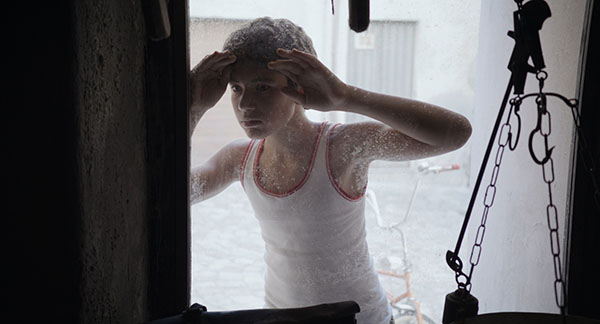The Properties of Metals concentrates on the fascinating collisions between hope and belief but doesn’t develop new dynamics on the topics it tackles.
Seeing is believing, but feeling is truth. This classic quote by Thomas Fuller, spoken in a religious context, suggests that belief and truth are two very separate matters altogether. If you see something for yourself, you might believe it to exist, even if it’s incredibly unusual for something like that to happen. That phrase fuels Antonio Bigini’s narrative feature debut, The Properties of Metals (Le Proprietà dei Metalli). A miracle-like act happens, and people are split on whether to believe it or not. This film centers around the collision between hope and belief – yearning and conviction.
The Properties of Metals takes inspiration from the televised performances of Israeli-British illusionist Uri Gellar, who shocked the world back in the day by bending metal just by touching various objects that were put upon him. This sparked a light onto many younglings, who after witnessing the performance were capable of doing the same paranormal phenomena (or magic tricks, depending on whether you believe or not) as Gellar. They were called the “minigellers”. Because of such an anomaly, scientists began experimenting on these kids and their unique gifts, but they never reached definitive conclusions on the odd “gift”.
Set in a small village in the Italian mountains in the 1970s, The Properties of Metals follows a young kid named Pietro (Martino Zaccara), raised by his widower father (Antonio Buíl). Pietro spends his days playing with the local children and his younger brother while his father tries to deal with his money problems, as ever since the loss of his wife, he has been having trouble trying to make ends meet.

But Pietro’s mysterious gift brings a shimmer of hope: he can bend metal objects by touching them. This gift comes to the attention of an American scientist (David Pasquesi), who begins to study Pietro and his unique ability. Is it all true? Can Pietro actually bend metal just by touching it? Or is it just a hoax? These questions pop into the character’s minds as well as your own in Bigini’s film. Most of the characters in the movie don’t believe these paranormal phenomena to be genuine. Their beliefs are tested because this miracle-like anomaly is occurring at a time of tragedy for them.
Pietro’s gift arrives conveniently, as his father’s current circumstances and struggles trigger it. A constant sensation of uncertainty is stuck in the film’s atmosphere thanks to Andrea Vaccari’s cinematography, which leans more on showing the characters from afar and occasionally their backs. How Bigini explores these topics reminds me of Sebastian Lelio’s adaptation of The Wonder, a film that centers around an anomaly that questions people’s devotion and how they react to them. Some believe it’s a godsend blessing, while others are looking at scientific fact or probability. In The Properties of Metals, there’s a similar dynamic between the deniers (the people partaking in the experiments) and the believers (the American scientist).
There’s this constant internal fight between the people who have perceived such acts. And since the audience watching the film doesn’t actually see such “miracles” but is only shown facial reactions from people, we are invested in this debate too – whether or not Pietro’s gift is a hoax. Unlike The Wonder, however, The Properties of Metals maintains a higher amount of hope regarding Pietro’s potential gift. In The Wonder, the non-believers, or skeptics, want to rapidly take down the fact that a young girl has survived without food for months and are prominent players in the narrative. Meanwhile, in Antonio Bigini’s film, the skeptics appear primarily during the end.
The Properties of Metals focuses more on what triggers Pietro’s abilities, as he can do it when people are looking nor at any given moment. Nevertheless, it is less effective in exploring the topics because it relies on repetition rather than developing new dynamics. The film only shows how this gift has affected less than a handful of people, which adds to the secretive element of the story, where only a small village can see this anomaly but doesn’t add many interesting layers in the long run. The film lacks the thematic expansion and creativity necessary to uplift a story that focuses on the clashes between longing and conviction. Most of the scenes have somewhat been seen before, and done better, in other films, such as the aforementioned The Wonder and Andrei Tarkovsky’s Stalker.
This creates some detachment from the fascinating story because you know where it is headed: there’s a lack of surprises along the journey. Regardless, Antonio Bigini does have a knack for the Italian neo-realism style, as he curates a somewhat eerie atmosphere filled with apprehension and directs great performances from its cast, particularly Martino Zaccara and David Pasquesi. The film might follow the direction you’d expect from a story like this, but its resolution at least stays with you.
The final words recall the intertwining between faith and economic disparity and make you think about the various anomalies you might have experienced or have perceived during your lifetime. Those unexplainable magical experiences deliver a fascinating spark to our ever-confusing lives – déjà vu, spectacles in nature, or other weird circumstances. It might not be the best film to tackle these topics, but at least you can see the talent behind Bigini’s directorial eye. The Properties of Metals has me excited to see what bold story he wants to tackle next and also reassess The Wonder, as they would make an outstanding double bill.
The Properties of Metals premiered at the Berlin Film Festival on February 18-24, 2023. Read our Berlin Film Festival reviews!

